Tuan Tran
LCFO: Long Context and Long Form Output Dataset and Benchmarking
Dec 12, 2024



Abstract:This paper presents the Long Context and Form Output (LCFO) benchmark, a novel evaluation framework for assessing gradual summarization and summary expansion capabilities across diverse domains. LCFO consists of long input documents (5k words average length), each of which comes with three summaries of different lengths (20%, 10%, and 5% of the input text), as well as approximately 15 questions and answers (QA) related to the input content. Notably, LCFO also provides alignments between specific QA pairs and corresponding summaries in 7 domains. The primary motivation behind providing summaries of different lengths is to establish a controllable framework for generating long texts from shorter inputs, i.e. summary expansion. To establish an evaluation metric framework for summarization and summary expansion, we provide human evaluation scores for human-generated outputs, as well as results from various state-of-the-art large language models (LLMs). GPT-4o-mini achieves best human scores among automatic systems in both summarization and summary expansion tasks (~ +10% and +20%, respectively). It even surpasses human output quality in the case of short summaries (~ +7%). Overall automatic metrics achieve low correlations with human evaluation scores (~ 0.4) but moderate correlation on specific evaluation aspects such as fluency and attribution (~ 0.6). The LCFO benchmark offers a standardized platform for evaluating summarization and summary expansion performance, as well as corresponding automatic metrics, thereby providing an important evaluation framework to advance generative AI.
Large Concept Models: Language Modeling in a Sentence Representation Space
Dec 11, 2024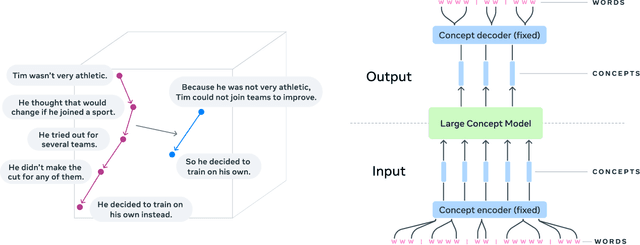

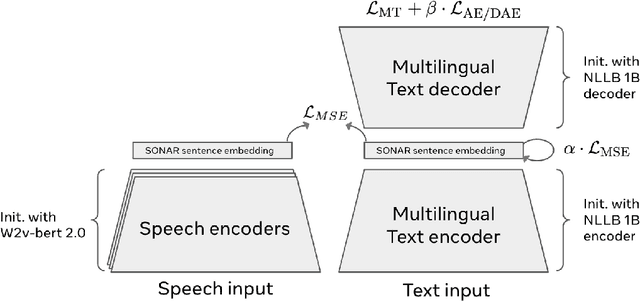
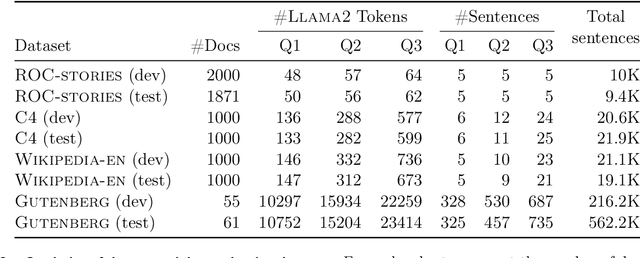
Abstract:LLMs have revolutionized the field of artificial intelligence and have emerged as the de-facto tool for many tasks. The current established technology of LLMs is to process input and generate output at the token level. This is in sharp contrast to humans who operate at multiple levels of abstraction, well beyond single words, to analyze information and to generate creative content. In this paper, we present an attempt at an architecture which operates on an explicit higher-level semantic representation, which we name a concept. Concepts are language- and modality-agnostic and represent a higher level idea or action in a flow. Hence, we build a "Large Concept Model". In this study, as proof of feasibility, we assume that a concept corresponds to a sentence, and use an existing sentence embedding space, SONAR, which supports up to 200 languages in both text and speech modalities. The Large Concept Model is trained to perform autoregressive sentence prediction in an embedding space. We explore multiple approaches, namely MSE regression, variants of diffusion-based generation, and models operating in a quantized SONAR space. These explorations are performed using 1.6B parameter models and training data in the order of 1.3T tokens. We then scale one architecture to a model size of 7B parameters and training data of about 2.7T tokens. We perform an experimental evaluation on several generative tasks, namely summarization and a new task of summary expansion. Finally, we show that our model exhibits impressive zero-shot generalization performance to many languages, outperforming existing LLMs of the same size. The training code of our models is freely available.
Proactive Detection of Voice Cloning with Localized Watermarking
Jan 30, 2024Abstract:In the rapidly evolving field of speech generative models, there is a pressing need to ensure audio authenticity against the risks of voice cloning. We present AudioSeal, the first audio watermarking technique designed specifically for localized detection of AI-generated speech. AudioSeal employs a generator/detector architecture trained jointly with a localization loss to enable localized watermark detection up to the sample level, and a novel perceptual loss inspired by auditory masking, that enables AudioSeal to achieve better imperceptibility. AudioSeal achieves state-of-the-art performance in terms of robustness to real life audio manipulations and imperceptibility based on automatic and human evaluation metrics. Additionally, AudioSeal is designed with a fast, single-pass detector, that significantly surpasses existing models in speed - achieving detection up to two orders of magnitude faster, making it ideal for large-scale and real-time applications.
Seamless: Multilingual Expressive and Streaming Speech Translation
Dec 08, 2023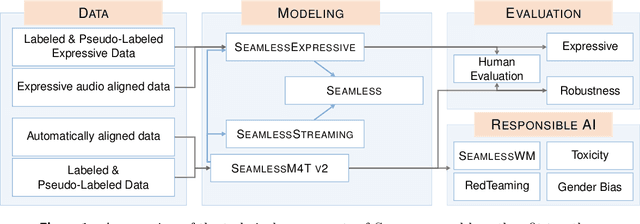
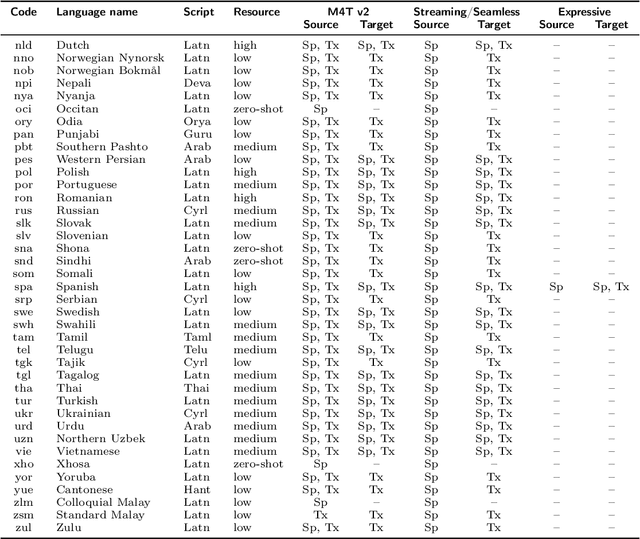

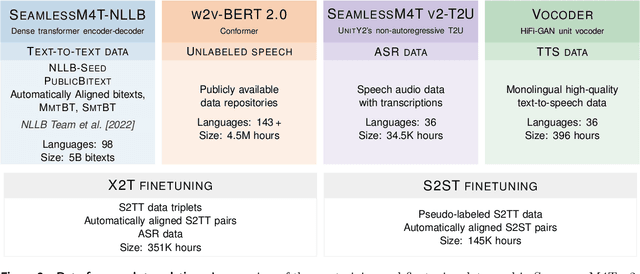
Abstract:Large-scale automatic speech translation systems today lack key features that help machine-mediated communication feel seamless when compared to human-to-human dialogue. In this work, we introduce a family of models that enable end-to-end expressive and multilingual translations in a streaming fashion. First, we contribute an improved version of the massively multilingual and multimodal SeamlessM4T model-SeamlessM4T v2. This newer model, incorporating an updated UnitY2 framework, was trained on more low-resource language data. SeamlessM4T v2 provides the foundation on which our next two models are initiated. SeamlessExpressive enables translation that preserves vocal styles and prosody. Compared to previous efforts in expressive speech research, our work addresses certain underexplored aspects of prosody, such as speech rate and pauses, while also preserving the style of one's voice. As for SeamlessStreaming, our model leverages the Efficient Monotonic Multihead Attention mechanism to generate low-latency target translations without waiting for complete source utterances. As the first of its kind, SeamlessStreaming enables simultaneous speech-to-speech/text translation for multiple source and target languages. To ensure that our models can be used safely and responsibly, we implemented the first known red-teaming effort for multimodal machine translation, a system for the detection and mitigation of added toxicity, a systematic evaluation of gender bias, and an inaudible localized watermarking mechanism designed to dampen the impact of deepfakes. Consequently, we bring major components from SeamlessExpressive and SeamlessStreaming together to form Seamless, the first publicly available system that unlocks expressive cross-lingual communication in real-time. The contributions to this work are publicly released and accessible at https://github.com/facebookresearch/seamless_communication
SeamlessM4T-Massively Multilingual & Multimodal Machine Translation
Aug 23, 2023
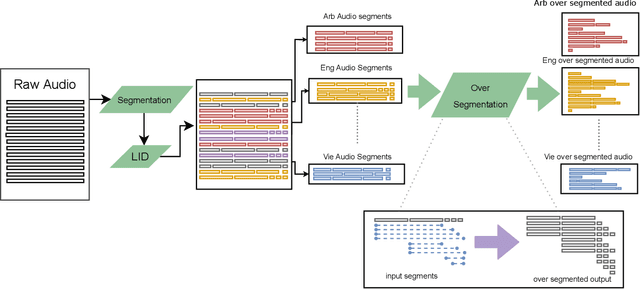
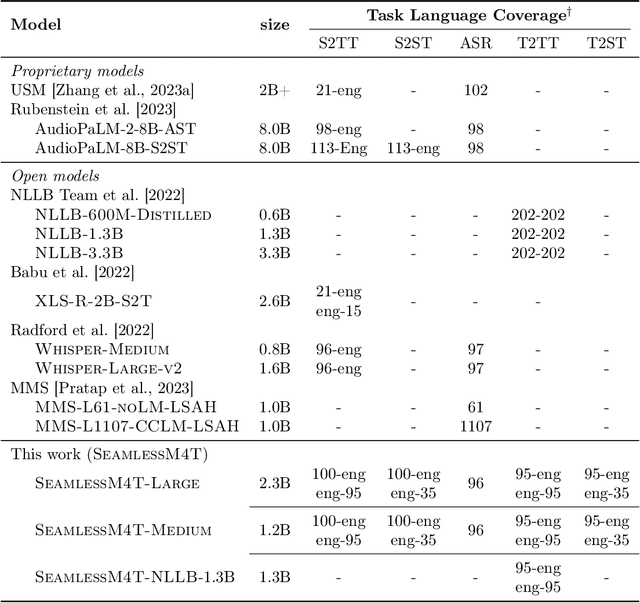
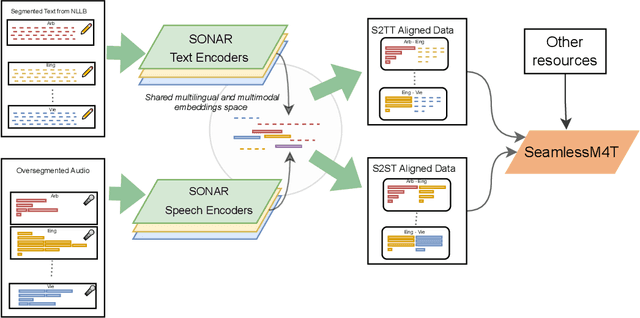
Abstract:What does it take to create the Babel Fish, a tool that can help individuals translate speech between any two languages? While recent breakthroughs in text-based models have pushed machine translation coverage beyond 200 languages, unified speech-to-speech translation models have yet to achieve similar strides. More specifically, conventional speech-to-speech translation systems rely on cascaded systems that perform translation progressively, putting high-performing unified systems out of reach. To address these gaps, we introduce SeamlessM4T, a single model that supports speech-to-speech translation, speech-to-text translation, text-to-speech translation, text-to-text translation, and automatic speech recognition for up to 100 languages. To build this, we used 1 million hours of open speech audio data to learn self-supervised speech representations with w2v-BERT 2.0. Subsequently, we created a multimodal corpus of automatically aligned speech translations. Filtered and combined with human-labeled and pseudo-labeled data, we developed the first multilingual system capable of translating from and into English for both speech and text. On FLEURS, SeamlessM4T sets a new standard for translations into multiple target languages, achieving an improvement of 20% BLEU over the previous SOTA in direct speech-to-text translation. Compared to strong cascaded models, SeamlessM4T improves the quality of into-English translation by 1.3 BLEU points in speech-to-text and by 2.6 ASR-BLEU points in speech-to-speech. Tested for robustness, our system performs better against background noises and speaker variations in speech-to-text tasks compared to the current SOTA model. Critically, we evaluated SeamlessM4T on gender bias and added toxicity to assess translation safety. Finally, all contributions in this work are open-sourced and accessible at https://github.com/facebookresearch/seamless_communication
IPCC-TP: Utilizing Incremental Pearson Correlation Coefficient for Joint Multi-Agent Trajectory Prediction
Mar 16, 2023Abstract:Reliable multi-agent trajectory prediction is crucial for the safe planning and control of autonomous systems. Compared with single-agent cases, the major challenge in simultaneously processing multiple agents lies in modeling complex social interactions caused by various driving intentions and road conditions. Previous methods typically leverage graph-based message propagation or attention mechanism to encapsulate such interactions in the format of marginal probabilistic distributions. However, it is inherently sub-optimal. In this paper, we propose IPCC-TP, a novel relevance-aware module based on Incremental Pearson Correlation Coefficient to improve multi-agent interaction modeling. IPCC-TP learns pairwise joint Gaussian Distributions through the tightly-coupled estimation of the means and covariances according to interactive incremental movements. Our module can be conveniently embedded into existing multi-agent prediction methods to extend original motion distribution decoders. Extensive experiments on nuScenes and Argoverse 2 datasets demonstrate that IPCC-TP improves the performance of baselines by a large margin.
On some studies of Fraud Detection Pipeline and related issues from the scope of Ensemble Learning and Graph-based Learning
May 10, 2022



Abstract:The UK anti-fraud charity Fraud Advisory Panel (FAP) in their review of 2016 estimates business costs of fraud at 144 billion, and its individual counterpart at 9.7 billion. Banking, insurance, manufacturing, and government are the most common industries affected by fraud activities. Designing an efficient fraud detection system could avoid losing the money; however, building this system is challenging due to many difficult problems, e.g.imbalanced data, computing costs, etc. Over the last three decades, there are various research relates to fraud detection but no agreement on what is the best approach to build the fraud detection system. In this thesis, we aim to answer some questions such as i) how to build a simplified and effective Fraud Detection System that not only easy to implement but also providing reliable results and our proposed Fraud Detection Pipeline is a potential backbone of the system and is easy to be extended or upgraded, ii) when to update models in our system (and keep the accuracy stable) in order to reduce the cost of updating process, iii) how to deal with an extreme imbalance in big data classification problem, e.g. fraud detection, since this is the gap between two difficult problems, iv) further, how to apply graph-based semi-supervised learning to detect fraudulent transactions.
Understanding Public Opinion on Using Hydroxychloroquine for COVID-19 Treatment via Social Media
Jan 01, 2022
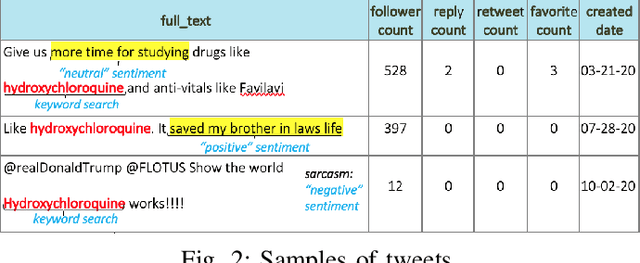
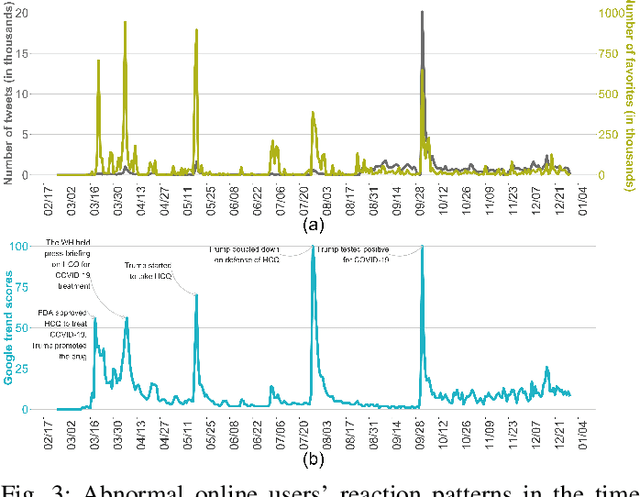
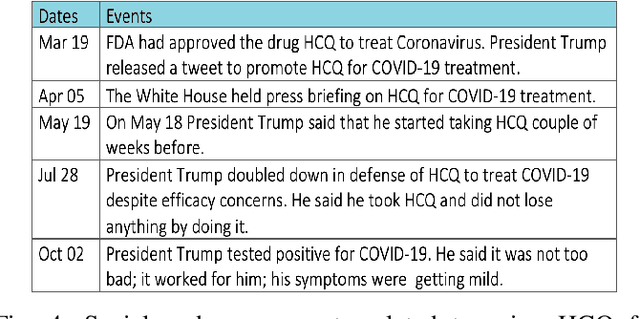
Abstract:Hydroxychloroquine (HCQ) is used to prevent or treat malaria caused by mosquito bites. Recently, the drug has been suggested to treat COVID-19, but that has not been supported by scientific evidence. The information regarding the drug efficacy has flooded social networks, posting potential threats to the community by perverting their perceptions of the drug efficacy. This paper studies the reactions of social network users on the recommendation of using HCQ for COVID-19 treatment by analyzing the reaction patterns and sentiment of the tweets. We collected 164,016 tweets from February to December 2020 and used a text mining approach to identify social reaction patterns and opinion change over time. Our descriptive analysis identified an irregularity of the users' reaction patterns associated tightly with the social and news feeds on the development of HCQ and COVID-19 treatment. The study linked the tweets and Google search frequencies to reveal the viewpoints of local communities on the use of HCQ for COVID-19 treatment across different states. Further, our tweet sentiment analysis reveals that public opinion changed significantly over time regarding the recommendation of using HCQ for COVID-19 treatment. The data showed that high support in the early dates but it significantly declined in October. Finally, using the manual classification of 4,850 tweets by humans as our benchmark, our sentiment analysis showed that the Google Cloud Natural Language algorithm outperformed the Valence Aware Dictionary and sEntiment Reasoner in classifying tweets, especially in the sarcastic tweet group.
Improved sparse PCA method for face and image recognition
Dec 01, 2021


Abstract:Face recognition is the very significant field in pattern recognition area. It has multiple applications in military and finance, to name a few. In this paper, the combination of the sparse PCA with the nearest-neighbor method (and with the kernel ridge regression method) will be proposed and will be applied to solve the face recognition problem. Experimental results illustrate that the accuracy of the combination of the sparse PCA method (using the proximal gradient method and the FISTA method) and one specific classification system may be lower than the accuracy of the combination of the PCA method and one specific classification system but sometimes the combination of the sparse PCA method (using the proximal gradient method or the FISTA method) and one specific classification system leads to better accuracy. Moreover, we recognize that the process computing the sparse PCA algorithm using the FISTA method is always faster than the process computing the sparse PCA algorithm using the proximal gradient method.
Text classification problems via BERT embedding method and graph convolutional neural network
Nov 30, 2021

Abstract:This paper presents the novel way combining the BERT embedding method and the graph convolutional neural network. This combination is employed to solve the text classification problem. Initially, we apply the BERT embedding method to the texts (in the BBC news dataset and the IMDB movie reviews dataset) in order to transform all the texts to numerical vector. Then, the graph convolutional neural network will be applied to these numerical vectors to classify these texts into their ap-propriate classes/labels. Experiments show that the performance of the graph convolutional neural network model is better than the perfor-mances of the combination of the BERT embedding method with clas-sical machine learning models.
 Add to Chrome
Add to Chrome Add to Firefox
Add to Firefox Add to Edge
Add to Edge